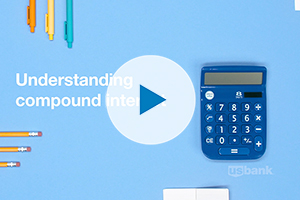
Certificates of deposit: How they work to grow your money

How compound interest works

You may remember the term “savings bonds” from a simpler time in your life. Chalk boards. Text books. Teenagers. Yup, we’re talking about high school history class. Savings bonds played an important role in America’s 20th century, and they’re still used today. Let’s brush up on our U.S. history before exploring whether savings bonds are right for you.
Savings bonds were first signed into legislation by Franklin D. Roosevelt to help Americans save money during the Great Depression. Amid economic crisis, people liked that saving bonds were a safe long-term investment. Because they are backed by the full faith and credit of the U.S. government, people knew they wouldn’t lose out if the economy dipped.
When you purchase a savings bond, you are essentially providing a loan to an entity – such as the U.S. government. Like with an IOU, the government agrees to pay you back later with interest. This made savings bonds an effective way for the government to raise funds during World War II. By the 60s and 70s, families liked to buy savings bonds to pay for higher education. They became even more popular in the 1990s when Congress created tax exemptions for bonds used to pay tuition.
Nowadays, savings bonds operate in much the same way. You still provide a loan to the government at very low risk. But now, bonds are sold primarily online through TreasuryDirect.gov instead of with paper certificates you can hide beneath your bed.
Bonds remain a safe, easy way to save and earn money over time. The Treasury guarantees to not only pay you back – but to double your initial investment over 20 years. Pretend you purchased a bond for $10,000 in 2020. By 2040, your bond will be worth at least $20,000 thanks to compounding interest payments from the government. After that, you can continue accruing interest for another 10 years. And bonus! When you redeem your bond, the money won’t be subject to state or local taxes. You may also enjoy federal tax deductions if you use your bond to fund higher education at an eligible intuition.
There are two types of bonds to choose from: Series EE bonds and Series I bonds.
Both earn monthly interest and can be purchased online in any amount from $25 to $10,000. However, the Series EE bond offers predictable fixed rates while the Series I bond has both a fixed-rate and a variable rate component. Your earnings will fluctuate based on inflation with the Series I.
Compare these bonds on the Treasury website.
How do savings bonds compare to other savings vehicles? And, more importantly, are they the right choice for your needs? Traditional savings and money market accounts allow you to earn interest and access your money right when you need it. Bonds, on the other hand, grow slowly in value and are worth the most after 20 to 30 years.
Consider savings bonds for your long-term savings goals. You can set money aside to earn interest, while resisting temptation to dip into your funds. But don’t rush into buying a bond. Today there are many saving vehicles designed for long-term saving – each with unique pros and cons. If you’re saving for education or retirement, Roth IRA and 529 accounts are popular options to explore. And they may offer better tax deductions or a higher Annual Percentage Yield (APY) than a savings bond.
Inspired to start saving? Explore these 9 simple ways to save.
Related content


